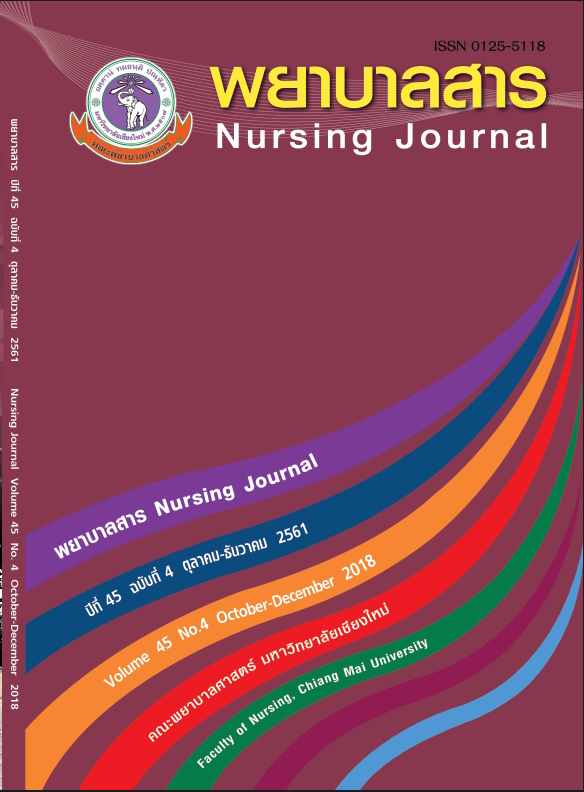ผลของโปรแกรมการเสริมสร้างพลังอำนาจมารดาร่วมกับการสัมผัสแบบอ่อนโยนต่อพฤติกรรมตอบสนองของทารกแรกเกิดน้ำหนักน้อย
คำสำคัญ:
ทารกแรกเกิดน้ำหนักน้อย, พฤติกรรมตอบสนองของทารกแรกเกิด, โปรแกรมการเสริมพลังอำนาจมารดาร่วมกับการสัมผัสแบบอ่อนโยน, การพยาบาลแบบปกติบทคัดย่อ
ทารกแรกเกิดน้ำหนักน้อยเสี่ยงต่อการเกิดปัญหาพฤติกรรมการตอบสนอง เนื่องจากระบบประสาทที่ยังพัฒนาไม่สมบูรณ์ และการขาดการกระตุ้นการสัมผัสจากมารดาที่ต่อเนื่อง การวิจัยนี้เป็นวิจัยกึ่งทดลองแบบศึกษาสองกลุ่มที่ไม่เท่าเทียมกันวัดแบบอนุกรมเวลา เพื่อเปรียบเทียบความแตกต่างพฤติกรรมการตอบสนองของทารกแรกเกิดน้ำหนักน้อยในมารดาครรภ์แรก ระหว่างกลุ่มทดลองที่ได้รับโปรแกรมการเสริมพลังอำนาจมารดาร่วมกับ การสัมผัสแบบอ่อนโยนและกลุ่มควบคุมที่ได้รับการพยาบาลแบบปกติคัดเลือกกลุ่มตัวอย่างแบบเฉพาะเจาะจงคือ ทารกแรกเกิดน้ำหนักน้อยที่เกิดจากมารดาครรภ์แรกที่ได้รับการรักษาในแผนกทารกแรกเกิดมีปัญหา โรงพยาบาลตำรวจ จำนวน 44 คน แบ่งเป็นกลุ่มทดลองและกลุ่มควบคุม กลุ่มละ 22 คน เครื่องมือที่ใช้ในดำเนินการวิจัย ได้แก่ โปรแกรมการเสริมพลังอำนาจมารดาร่วมกับการสัมผัสแบบอ่อนโยน เครื่องมือที่ใช้ในการเก็บรวบรวมข้อมูล ได้แก่ แบบประเมินพลังอำนาจของมารดา และแบบประเมินพฤติกรรมการตอบสนองทารก ผ่านการประเมินโดยผู้ทรงคุณวุฒิ วิเคราะห์ข้อมูลโดยใช้สถิติพรรณนา และสถิติแปรปรวนสองทางแบบวัดซ้ำ (Two-Way Repeated Measure ANOVA) ผลการศึกษาพบว่า
1. พฤติกรรมการหลับตื่นของทารกแรกเกิดน้ำหนักน้อยกลุ่มทดลอง และกลุ่มควบคุม มีความแตกต่างกันในพฤติกรรมกลุ่ม Quit sleep, Drowsy, Awake alert, Active awake และ Crying แต่ไม่พบความแตกต่างในพฤติกรรมกลุ่ม Active sleep อย่างมีนัยสำคัญทางสถิติที่ .05
2. พฤติกรรมการเคลื่อนไหวร่างกายของทารกแรกเกิดน้ำหนักน้อยกลุ่มทดลอง และกลุ่มควบคุม มีความแตกต่างกันในพฤติกรรมกลุ่ม Behavioral distress cues, No movement และ Smiles แต่ไม่พบความแตกต่างในพฤติกรรมกลุ่ม Motor Activity อย่างมีนัยสำคัญทางสถิติที่ .05
References
Ardura, J., Andrés, J., Aldana, J., & Revilla, M. A. (1995). Development of sleep–wakefulness rhythm in premature babies. Acta Pædiatrica, 84(5), 484-489.
Brazelton, T.B. (2013). Understanding the Baby's Language[Online]. Available from: http://www.brazelton institute.com/intro.html[2016,Mar 10]
Burns, N., and Grove, S. K. (2009).The Practice of Nursing Research: Appraisal, synthesis, and generation of evidence,Six edition. St. Louis, Missouri: Saunders.
Hinsil, J. (2006). Maternal participation in caring for high-risk neonates. Master’s Thesis, Pediatric Nursing, Graduate School, Chiang Mai University.
Garcia, A., P. & White-Traut, R., C. (1993). “Preterm infants’ responses to taste/smell and tactile stimulation during an apneic episode”. Journal of Pediatric Nursing, 8, 245- 252.
Gardner, F., & Shaw, D. S. (2009). Behavioral Problems of Infancy and Preschool Children (0–5) Rutter's Child and Adolescent Psychiatry (pp. 882-893): Blackwell Publishing Ltd.
Gibson, C. H. (1995). The process of empowerment in mothers of chronically ill children. Journal of Advanced Nursing, 21(6), 1201-1210. doi: 10.1046/j.1365-2648.1995.21061201.x
Harrison, L. L. (2004). Touch And Massage In Early Child Development: USA.
Harrison, L. L., Leeper, J. D., & Yoon, M. (1990). Effects of early parent touch on preterm infants’ heart rates and arterial oxygen saturation levels. Journal of Advanced Nursing, 15(8), 877-885. doi: 10.1111/j.1365-2648.1990.tb01942.x
Im, H., Kim, E., & Cain, K. C. (2015).Acute effects of Yokson and Gentle Human Touch on the behavioral state of preterm infants. jounals Permissions.nav, 13(3), 212-226.
Jones, N. A., & Mize, K. D. (2007). Low-Cost Approaches to Promote Physical and Mental Health: Johnson & Johnson Pediatric Institute, L.L.C.
Kansiri, S. (2550). Develop a clinical nursing practice guideline (CNPG) for Empowerment Model for Mother of Premature-Infant. Master of Nursing Science in Community Nurse Practitioner, Faculty of Nursing, Thammasat University.
March of Dimes. (2003). Infant Behavior, Reflexes and Cues[Online]. Available from:https://www.marchofdimes.org/nursing/modnemedia/othermedia/infantBehavior.pdf
Modrcin-McCarthy, M. (1992). The physiological and behavioral effects of a gentle human touch nursing intervention on preterm infants (Order No. 9319218). Available from ProQuest Dissertations & Theses Global; ProQuest Nursing &Allied Health Source. (304027307). Retrieved from http://search.proquest.com/docview/304027307?accountid=15637
Modrcin-Talbott, M. A., Harrison, L. L., Groer, M. W., & Younger, M. S. (2003). The Biobehavioral Effects of Gentle Human Touch on Preterm Infants. Nursing Science Quarterly, 16(1), 60-67.
Paehsakun, C., & Thanattheerakul, C. (2010). Maternal Participation in Caring for High-Risk Neonate. The Journal of Boromarajonani College of Nursing, Nakhonratchasima, 16(1), 39-49.
Pakanta, I. (2007). Sleep Problems and Interventions. Journal of Nursing Science Naresuan University. 1(2), 31-38.
Teerarungsikul, N. (2003). Nursing care for premature infants. Bangkok: P. Press Co.,LTD.
Schenk, L. K., Kelley, J. H., & Schenk, M. P. (2005). Family matters. Models of maternal-infant attachment: a role for nurses. Pediatric Nursing, 31(6), 514-517 514p.
Smith, J. R. (2012). Comforting Touch in the Very Preterm Hospitalized Infant: An Integrative Review. Advances in Neonatal Care, 12(6), 349-365.
Downloads
เผยแพร่แล้ว
How to Cite
ฉบับ
บท
License
บทความที่ได้รับการตีพิมพ์เป็นลิขสิทธิ์ของวารสารพยาบาลสาร
ข้อความที่ปรากฏในบทความแต่ละเรื่องในวารสารวิชาการเล่มนี้เป็นความคิดเห็นส่วนตัวของผู้เขียนแต่ละท่านไม่เกี่ยวข้องกับมหาวิทยาลัยเชียงใหม่ และคณาจารย์ท่านอื่นๆในมหาวิทยาลัยฯ แต่อย่างใด ความรับผิดชอบองค์ประกอบทั้งหมดของบทความแต่ละเรื่องเป็นของผู้เขียนแต่ละท่าน หากมีความผิดพลาดใด ๆ ผู้เขียนแต่ละท่านจะรับผิดชอบบทความของตนเองแต่ผู้เดียว





